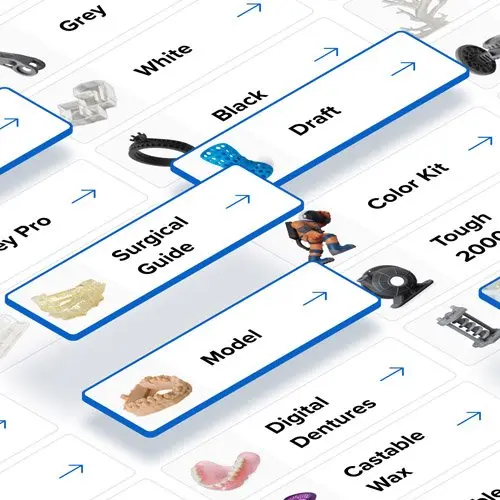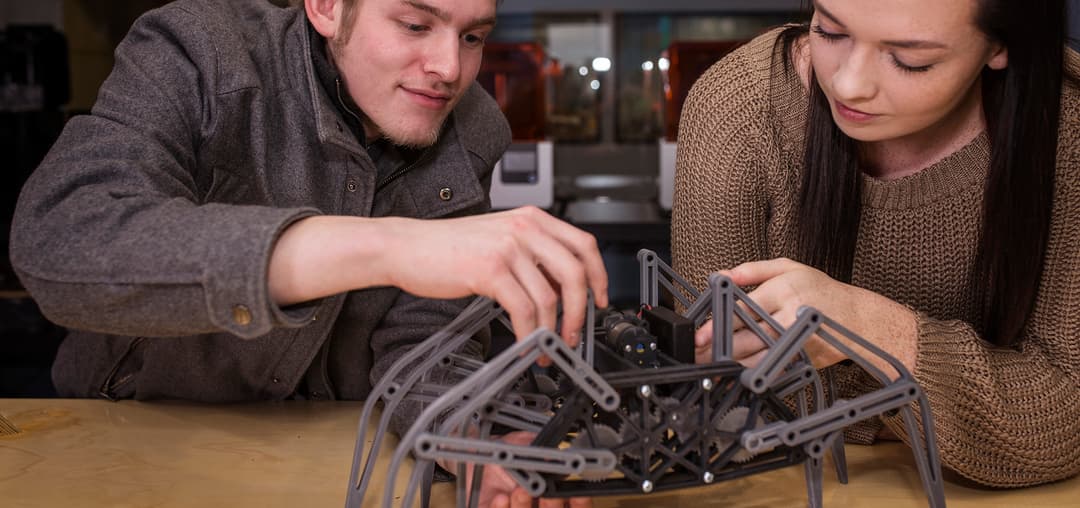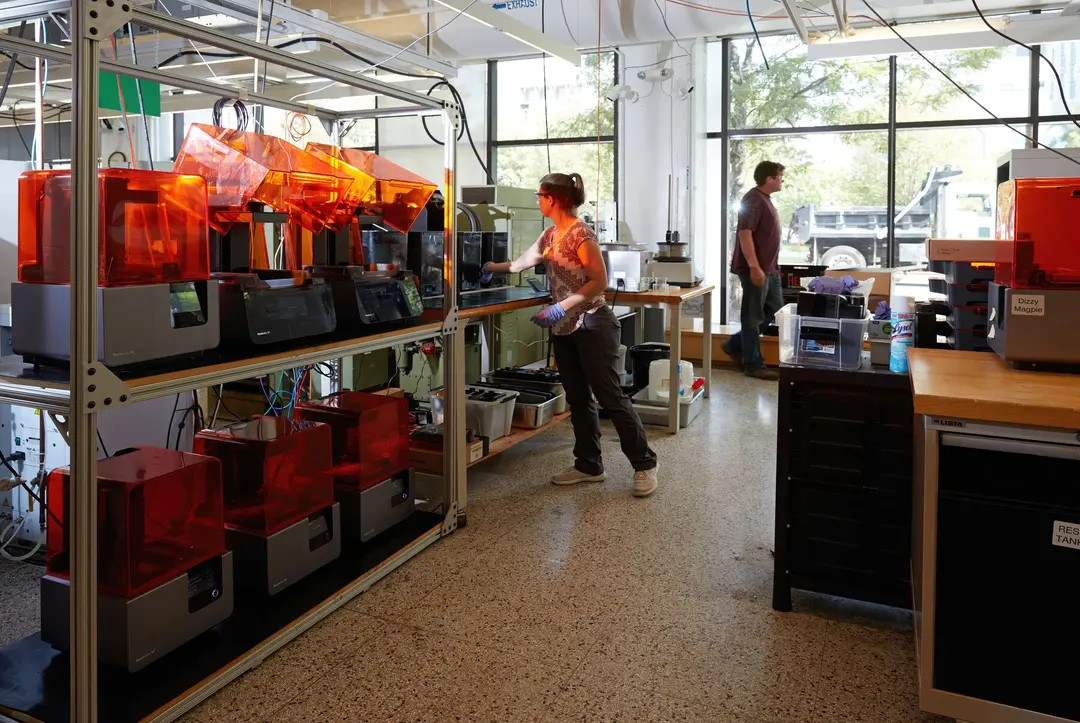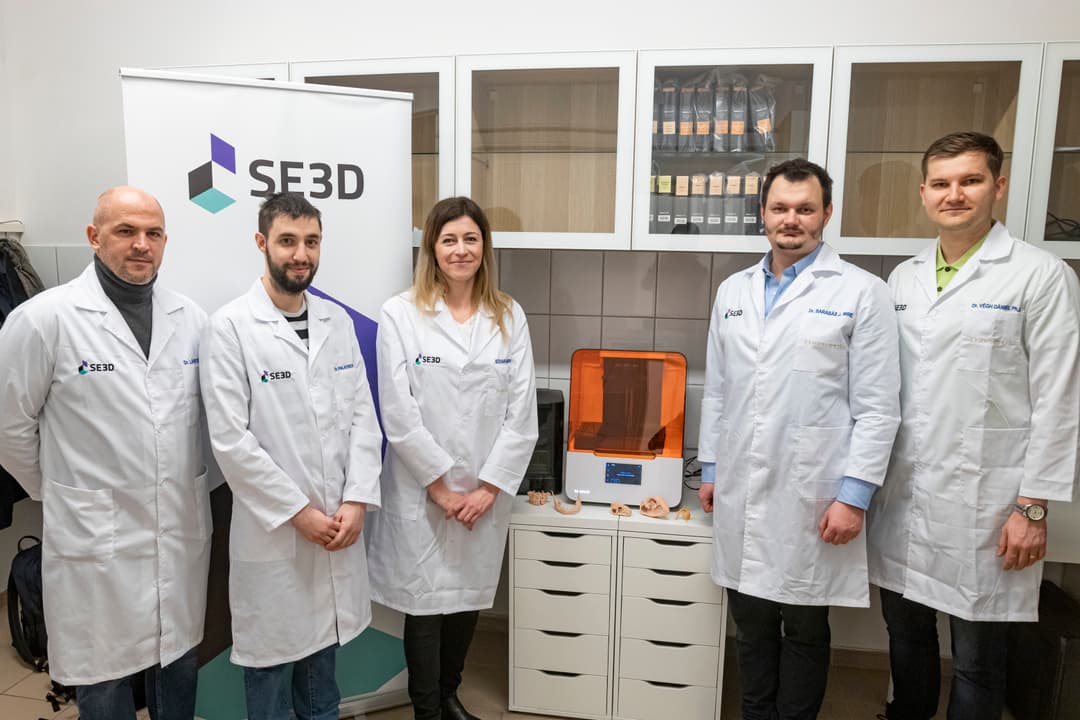3D printing has the power to elevate the classroom. With applications extending far beyond engineering courses, 3D printing prepares students for the job market, helps students develop analytical skills, and activates their creativity. Before educators at K12 schools and universities can optimize 3D printing for the classroom, they need to familiarize themselves with the 3D printing ecosystem, which extends beyond the printer itself. There are multiple factors to consider: 3D design, hardware, software, and materials. With a wide range of materials in our library, Formlabs can help educators select the perfect resins for their classes, both in-person and online.
In this blog post, we review to select the optimal materials. We cover the following steps:
-
Set your objectives for 3D printing in the classroom.
-
Learn about the unique characteristics of different resins.
-
Tailor your resins to your lesson plans.

Find the Right Material for Your Application
Need some help figuring out which 3D printing material you should choose? Our new interactive material wizard helps you make the right material decisions based on your application and the properties you care the most about from our growing library of resins.
Set Your Objectives for 3D Printing in the Classroom
Incorporating 3D printing in the classroom involves setting clear objectives and expectations for your classroom learning outcomes. What would you like your students to achieve with 3D printing? Broad objectives can include improving modeling and fabrication skills, learning how to problem-solve real-life scenarios with 3D printing, identifying time and cost saving opportunities with 3D printing, increasing engagement with digital technologies, and expanding imaginations. These objectives can be further specified for different academic disciplines. By carefully assessing how 3D printing can enhance learning, educators across all academic disciplines can create a strong 3D printing program.
3D printing has long proven its use in engineering applications like jigs and fixtures, most of which educators can use to to embed a wide range of 3D printing-aided objectives into their engineering coursework. Because additive manufacturing offers more design freedom than subtractive manufacturing, educators can set goals for covering more topics and producing more work in a semester. They can also encourage students to develop computational thinking skills and spend more time on hands-on learning.
Medical fields also show great promise for 3D printing. 3D printing plays a critical role in training future doctors and nurses and preparing them for real-life operations by producing realistic models.
For example, Surgical Resin is used for experimental applications and Elastic Resin is used for prototyping device parts. Elastic Resin also simulates soft tissue such as skin.
In art, design, and architecture disciplines, 3D printing helps students imagine new possibilities and bring them to life. For example, students studying metalsmithing can use CAD software to design different wearable jewelry pieces and students studying architecture can construct highly detailed physical models. Jewelry designer and Formlabs Ambassador Jocelyn DeSisto incorporated 3D printing to tackle design challenges. Her jewelry company Lot28 produces jewelry with intricate surface detailing that is hard to replicate by hand. “Similar to a template of a drawing, I am able to maximize design time when creating a 3D model and then print multiple iterations without the lag of hand fabrication time,” she said.
Learn About the Unique Characteristics of Different Resins
Different resins boast unique characteristics; no two resins are the same. Their different characteristics suit varying needs--for example, Tough 2000 Resin suits prototyping strong and sturdy parts that should not bend easily. Here, we’ll go over some of our resins and how their distinctive qualities can support different learning outcomes.
Draft Resin
Perfect for prototyping, Draft Resin prints three to four times faster than other Standard Resins. The material is named for its ability to print large parts quickly and cycle through multiple design iterations in one day. With a 300 micron layer height, it’s accurate enough to meet prototyping needs while enabling faster design iterations.
Because Draft Resin is designed for rapid prototyping, it suits engineering coursework that requires students to test and iterate. Using Draft Resin can make engineering classes more efficient--models that would’ve taken 10 hours to print can be completed in two. Draft Resin prints quickly without sacrificing quality.
Lance Winkel, a senior lecturer at the USC Viterbi School of Engineering, used Draft Resin to accelerate ideation for projects. Draft Resin has saved both Winkel and his students time. “Draft Resin can often be as much as four times faster to complete a stage. The same Form 2 printer using Standard Grey Resin completed a recent print in 12 hours,” Winkel said. “The same exact stage layout, but with only some slight print support adjustments to accommodate Draft Resin, finished in just under 3 hours! It means that four times as many projects or iterations can be completed by the same printer in the same amount of time. That is transformational.”
Elastic Resin
Elastic Resin is the most pliable of Formlabs’ Engineering Resins. Parts printed in this material look and behave like a molded silicone part, and are durable enough to use for multiple cycles. Soft but resilient, Elastic Resin is a part of an emerging category called Elastomeric Materials. Typically, soft silicone and urethane parts for applications like wearables, medical models, robotics, and special effects props are produced through mold-making techniques or outsourcing. Some soft materials for direct 3D printing have started to appear, but parts printed in these materials might only last for one or two cycles, and don’t offer the feel expected from a “silicone-like” part. Developing soft stereolithography (SLA) resins can be challenging. Parts must be highly elastic, yet strong enough not to tear during printing—two properties that are typically diametrically opposed.
Elastic Resin can easily be used in medical school or science classes. The healthcare field uses patient-specific anatomical models to prepare for operations. Medical students can prepare for their careers by using 3D printed models. The opaque nature of Elastic Resin helps students visualize internal cavities and its durability means they don’t have to worry about their models breaking.
Tough 2000 Resin
Tough 2000 Resin produces stiff and sturdy parts that are difficult to bend. This material is ideal for functional parts such as housings and enclosures, jigs and fixtures, mechanical connectors, and prototypes undergoing wear and tear.
Tough 2000 Resin is the strongest and stiffest material in our newly segmented family of Tough and Durable Resins. These materials, which include Tough 2000 Resin, Tough 1500 Resin, and Durable Resin, can all handle compression, stretching, bending, and impacts without breaking, but can be clearly differentiated by comparing key properties such as modulus.
Due to the improved strength, stiffness, and elongation, Tough 2000 Resin is optimal for product design and engineering courses where students are required to produce functional parts that can withstand wear and tear.
Tailor Your Resins to Your Lesson Plans
3D printing can form the core of your lesson plan, or be used as a tool to support learning. Materials undoubtedly play a critical role in higher education 3D printing lesson planning. Educators can leverage more than one resin, using a combination of them to suit their learning outcomes.



